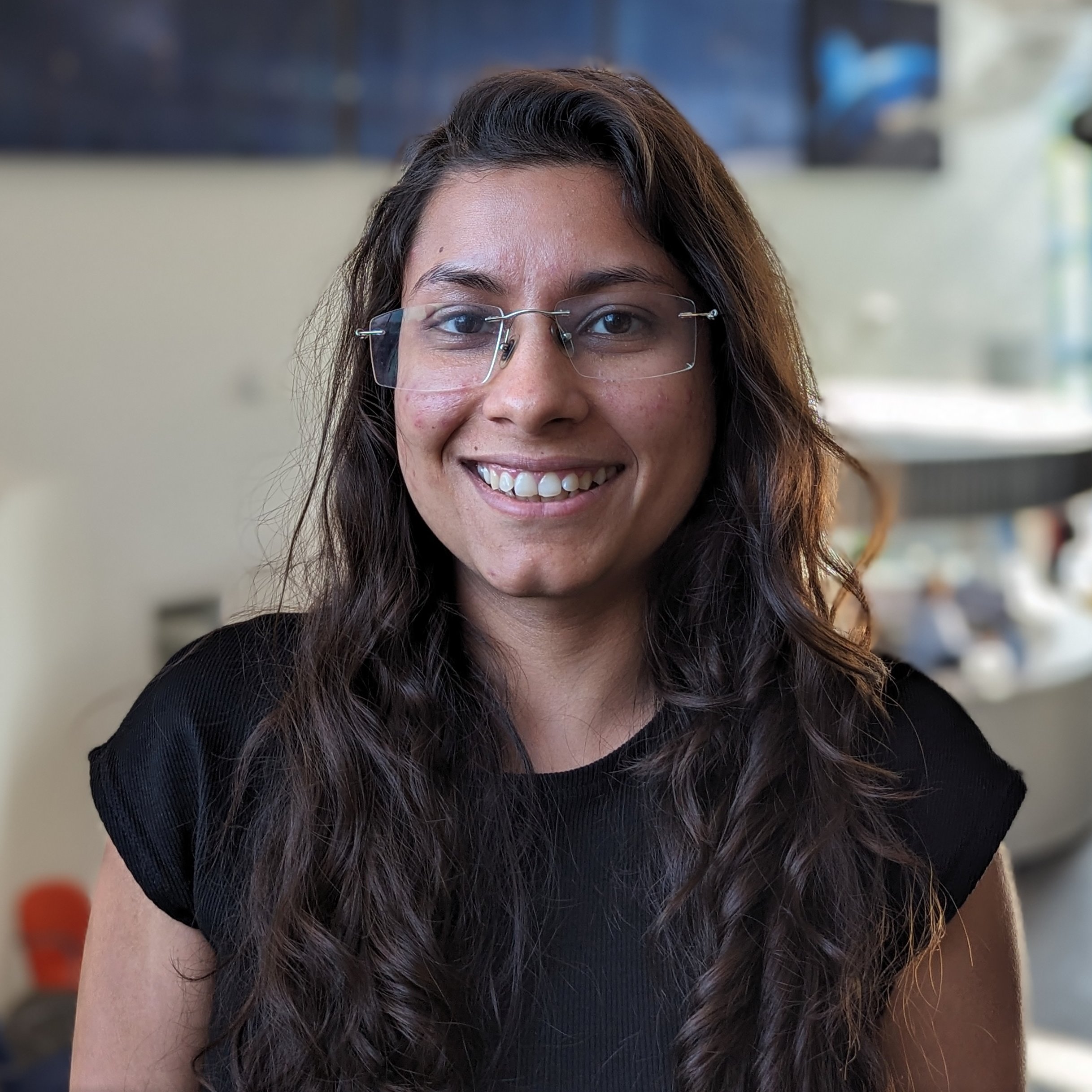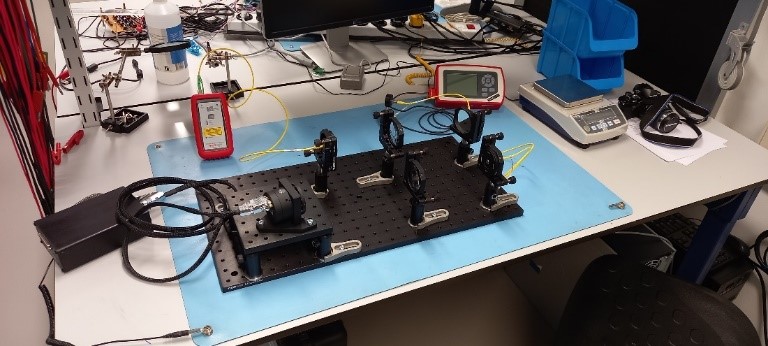About the Group
Laser satellite communications provide a bright perspective for satellite communications. Currently, satellite communications using radio frequencies (RF) run into limitations in terms of available frequency slots, data throughput, and security. At the same time, the demand for data volume and security is increasing. Laser satellite communications have the potential to supplement satellite RF communications to provide for that need.
Our Laser Satellite Communications expert group consists of PhD-candidates from different TU Delft faculties (Aerospace Engineering and Civil Engineering), MSc students from Aerospace Engineering that do their MSc thesis on laser satellite communications, and University staff working on this topic. Given the availability of equipment for optical fibre communications, we advance the understanding of the challenges to bring optical communications to and from space. This involves research on optical propagation through free space, through atmospheric turbulence and the understanding of atmospheric turbulence.
We also focus on novel techniques, such as the multi-beam terminal and applications that use optical communications, such as ranging. With the acquired knowledge of the challenges, we contribute to the development of mitigation techniques such as Adaptive Optics, that are relevant for our industrial partners.
Contact

Dr.ir. R. (Rudolf) Saathof
Assistant Professor
✉ R.Saathof@tudelft.nl
Research Projects
Optical modelling for satellite free space and quantum communication
Optical and quantum communication satellites will be exposed to periodic thermo-mechanical loads that will affect the optical performance of the system. In this project, mathematical and computational optical models are built to better understand and quantify the impact of these phenomena. This project focuses on optimizing the performance of satellite optical and quantum communications through beam-shaping techniques, using conventional optical systems and metasurfaces.
M. (Mario) Badás Aldecocea
PhD Candidate
M.BadasAldecocea@tudelft.nl
Design and control of space based multi-beam laser communication terminals
To integrate free space optical communication into nodal communication networks and make multi-user satellites possible through laser communication, multi-beam laser communication terminals are needed. These accommodate multiple unique laser communication links within one terminal. The main challenge with this technology being investigated is steering multiple beams at the same time. Therefore, research into the design and control of multi-beam steering stages is the central focus of the project. Furthermore, a core part of this research is the demonstration of these theories with real hardware.
J.J. (Joshua) Spaander
PhD Candidate
J.J.Spaander@tudelft.nl
Inter-satellite ranging using laser communication terminals
To control satellites in formation flying, precise distance measurement or ranging between collaborating satellites is needed. Future satellites are anticipated to carry Laser Communication Terminals (LCTs) due to their small size and high data rates. Therefore, to prevent the need for separate ranging instruments, this research aims to use the state-of-art LCTs for inter-satellite ranging. The challenge is to perform high-precision range measurements without affecting the communication data rates. In this project, the laser communication system is being modelled to quantify the systematic errors and hence the achievable ranging performance of these LCTs. This study will also identify the main limiting issues and the potential applications of such a combined system.
R. (Rashika) Jain
PhD Candidate
R.Jain-1@tudelft.nl
Channel effects in space-to-ground communication
Laser Satellite Communication is a high-potential technology with many advantages compared to classical RF links, offering high throughput, better pointing accuracy, and more security. Such optical links are however notably affected by atmospheric perturbations including those caused by atmospheric turbulence. In an effort to better monitor and understand the impact of these disturbances, this project intends to achieve better ways of evaluating turbulence related parameters like the \(C_n^2\) in Urban environments, by, for instance, using Machine Learning and comparing to experimental data from an actual cubesat link.
M. (Marguerite) Arvis
PhD Candidate
M.Arvis@tudelft.nl
Modelling Atmospheric Optical Turbulence using Machine Learning
Free-space optical communication (FSOC) links are considered a key technology to support the increasing needs of our connected, data-heavy world, but they are prone to disturbance through atmospheric processes such as optical turbulence. Since turbulence is highly dependent on local topographic and meteorological conditions, modeling optical turbulence strength \(C_n^2 \) during the design phase of an optical link or network is challenging. Traditional physics-based parameterizations or numerical models are often too simplistic or too computationally expensive to evaluate over large timeframes and areas. Therefore, this project aims to develop robust and reliable machine learning-based \(C_n^2\) models to bridge this gap.
M. (Maximilian) Pierzyna
PhD Candidate
M.Pierzyna@tudelft.nl
Laser Propagation through Turbulent Atmospheres using Physics-Informed Machine Learning
Whilst optical communications have the potential to revolutionise global telecommunications, laser beams are susceptible to perturbations including atmospheric turbulence which can degrade signal quality. Though these laser communication channels can be modelled, the modelling is typically computationally expensive. This project aims to pioneer novel physics-informed machine learning algorithms to formulate optical link performance maps, and to employ adaptive optics to mitigate the received signal loss.
I. (India) Walford
PhD Candidate
I.F.Walford@tudelft.nl
Physics-informed deep learning methods for super-resolution and forecasting of atmospheric data
Our approach leverages high-resolution in-situ observations, which provide data that is closer to the ground truth compared to public datasets like CERRA and ERA5. However, due to the limited availability of these in-situ observations, we integrate them with larger but lower-resolution datasets like CERRA and ERA5 to enhance the resolution of our models. This will enable us to create high-fidelity atmospheric models that are essential for accurately predicting optical turbulence.
C. (Carlo) Saccardi
PhD Candidate
C.Saccardi@tudelft.nl
Photonic Integrated Circuits for Pointing, Acquisition and Tracking of Satellites
Free Space Optical Communication comes with the advantage of higher bandwidth and data rates compared to RF frequency. Implementing a satellite to ground (and vice versa) optical link currently require a telescope and bulk optics to correct for atmospheric turbulence and point ahead angle of the satellite. To avoid misalignment and thermal drift errors of onboard bulk optics in satellites, the project introduces a PIC (Photonic Integrated Circuit) to replace said bulk components providing a more compact and efficient solution in the acquisition and tracking of the satellite.
R. (Rahil) Shajahan
PhD Candidate
R.Shajahan@tudelft.nl
Link Design and Performance Analysis in FSO Systems
Free space optical communication (FSO) plays a significant role as a complementary technology to the radio frequency (RF) systems. It offers high speed, highly secure, and cost-effective wireless connectivity through the use of laser beams and is able to provide users’ need such as voice, data and video transfer. However, such systems are subject to atmospheric effects including turbulence, aerosol absorption, and scattering that cause a reduction in communication performance. Turbulence causes deformations on the wavefront of the propagating beam which results in a deviation in the optical entities, e.g., beam scintillation, beam spread and beam wandering. In this project, we explore the propagation characteristics of laser beams using both analytical and simulation models, and propose techniques like adaptive optics, beam shaping, and spatial diversity to mitigate turbulence and enhance system performance.
Dr. M. (Muhsin) Gökçe
Postdoctoral researcher
M.C.Gokce@tudelft.nl
Facilities
The aim of the facility is to support understanding of the behaviour of the optical channel in the presence of turbulence, the interaction of the optical channel with the opto-mechatronic equipment and the development of novel technologies to improve channel performance. To that end, it consists of sky observation equipment, that monitors cloud cover, turbulence and optical attraction, and an optical ground station that intends to observe the integral effect of the opto-mechatronic system and the turbulence.
The aim of the FSOC testbed is to provide an experimentation environment to test and develop novel technologies. Several optical breadboards and a variety of optical, opto-electronic, and communications equipment are available for laboratory and in-field testing. This offers researchers as well as students the opportunity to build, develop and test their ideas in a laboratory environment and in real life.
Publications
-
Intercomparison of flux-, gradient-, and variance based optical turbulence (Cn2) variations Maximilian Pierzyna, Oscar Hartogensis, Sukanta Basu, and Rudolf Saathof
A multi-physics ensemble modeling framework for reliable Cn2 estimation Maximilian Pierzyna, Rudolf Saathof, and Sukanta Basu Field test demonstration of Adaptive Optics pre-correction for a Terabit Optical Communication Feeder Link K.A. Broekens, N.J. Doelman, W.A. Klop, F. Silvestri, G.C. do Amaral, Y. Vos, E.P. Veldhuis, T.-C. Bui, C.W. Korevaar, I. Ferrario, R. Saathof Joshua Spaander, Jian Guo, Rudolf Saathof, and Eberhard Gill Impact of transmitter wavefront errors and pointing jitter on intersatellite free space optical communications Mario Badás Aldecocea, Jasper Bouwmeester, Pierre Piron, Jérôme Loicq Relative distance measurements using inter-satellite optical communication links Rashika Jain, Stefano Speretta, Dominic Dirk, Eberhard Gill On the optimum far-field irradiance distribution using Laguerre-Gaussian beams for intersatellite free-space optical communications Mario Badás, Pierre Piron, Jasper Bouwmeester, and Jérôme Loicq Inter-satellite tracking methods and applications: A comprehensive survey
Rashkia Jain, Stefano Speretta, Dominic Dirkx, Eberhard Gill











